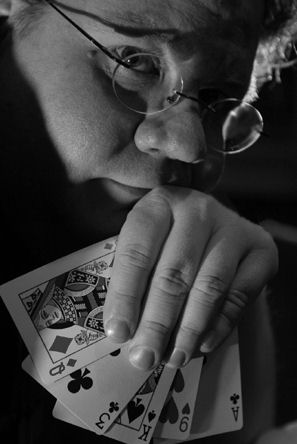Not yet a city and barely a town, Chicago needed a respite from the business of survival. It came in the form of a Mr. Bowers. He declared that he was a Professeurs de Tours Amusant. The fancy pigeon French aside, he was one of the early itinerant performers to visit the edge of the new Grand Prairie that the city opened up. He made our history by being the first professional performer to charge admission to exhibit in Chicago.
The 13th issue of the Chicago Democrat, February 18, 1834.
“Joy hath its limits. We but borrow one hour of mirth from months of sorrow.”
The ladies and gentlemen of Chicago are most respectfully informed that Mr. Bowers, Professeurs de Tours Amusant, has arrived in town and will give an exhibition at the house of Mr. D. Graves on Monday evening next.
PART FIRST
Mr. Bowers will fully personate Monsieur Chaubert, the celebrated Fire King, who so astonished the people of Europe, and go through his wonderful Chemical Performance. He will draw a red-hot iron across his tongue, hands, etc. and will partake of a comfortable warm supper by eating fire-balls, burning sealing wax, live coals of fire and melted lead. He will dip his fingers in melted lead, and make use of a red-hot iron to convey the same to his mouth.
PART SECOND
Mr. Bowers will introduce many amusing feats of Ventriloquism and Legerdemain, many of which are original and too numerous to mention. Admittance 50 cents, children half price. Performance to commence at early candle light. Seats will be reserved for ladies, and every attention paid to the comfort and convenience of the spectators. Tickets to be had at the bar.
Mr. D. Graves is Dexter Graves, one of Chicago’s founders. In 1833, He built an inn, Mansion House, on the north side of Lake Street near Dearborn. Many sources list this as block 18, but examining early Chicago maps show block 17 is near Dearborn.
Other than this advertisement, nothing is known of Mr. Bowers. I expect as more and more early newspapers are added to digital files we will learn addition information. We can we learn some from his ad.
It was not unusual to trade on the name of a more famous performer. At least, he gives credit. Chaubert had a disastrous tour of America and returned to Europe where he made his fame. Most of his, and Mr. Bowers’, stunts were common among the class of performers known as fire-eaters. While Mr. Bowers recreates the fire portion of Chaubert’s show, he leaves out the part where Chaubert ingested various poisons to no effect.
The probably didn’t use a ventriloquist dummy when he performed, most performers of this age didn’t. He may have used some simple hand puppets. Many performers had voices emanate from common household items. A saltshaker, a plate, a fork, each with its own voice and tale to tell. Perhaps he had a bottle of whiskey give a humorous discourse on temperance.
The magic at the time is also predictable. Tricks with eggs, such as a version of the egg bag, was common to performers. Card effects and coin effects, vanishes and productions, and the Cups and Balls filled out the repertoire of the traveling performer.
Mr. Bowers must have been a hit because immediately he, or more likely Mr. Graves, advertised a second day’s performance, on Wednesday February 24.
Further Reading
About Chaubert and other incombustible performers, Ricky Jay’s Learned Pigs and Fireproof Women
For information on early Ventriloquism, Stanley Burns, Other Voices
Most of my conjecture on early magic comes from the writings of Ricky Jay and Milbourne Christopher, Illustrated History of Magic.
The original ads came to my attention in A. T. Andreas, History of Chicago.
The Chicago Public Library has microfilm archives of the Chicago Democrat where I obtained copies of the original ads.


No comments:
Post a Comment